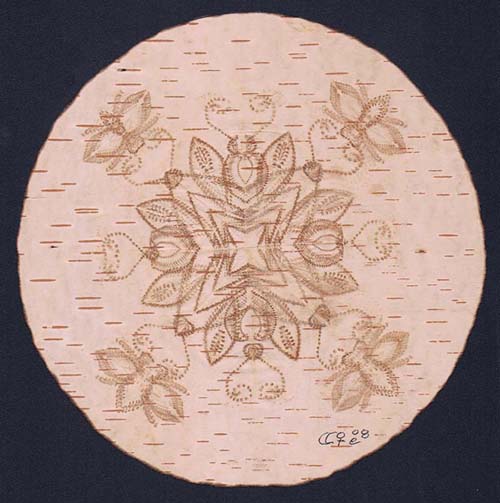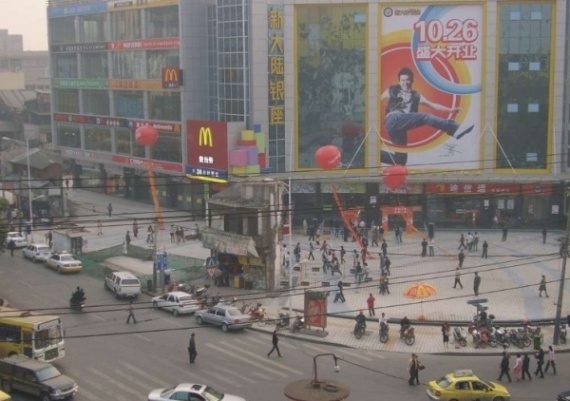Santo Niño de las Suertes
in Ephemera, Iconography
I found this tiny image in a Santería shop in Chicago, and I have always felt a connection to it — possibly due the dreams I had as a child. I believe I paid $1 for it.
Wikipedia says that:
The Niño de las Suertes is has a strong following due to its association with Santa Muerte. While the image was created in the 19th century, its popular veneration is a recent phenomenon. The image was found by two evangelists in the rubble of the Hacienda of San Juan de Dios in Tlalpan. It was handed over to Archbishop Francisco Lizana y Beaumont. As a number of monasteries wanted to claim it, the archbishop decided to make the decision by lottery. It is said that this image favored theConvent of San Bernardo due to the vow of poverty by its nuns. This was confirmed by doing the drawing three times. In the 19th century, due to tensions between the Mexican government and the Church, the image was moved to Tacubaya when the convent was secularized.
As for Tacubaya, the current home of the image, Wikipedia states:
Located only ten minutes away from the Mexican president’s residence of Los Pinos, La Ciudad Pérdida (The Lost City) of Tacubaya are small shacks made of cardboard, wood and other found items that line the narrow streets in a part of the neighborhood, on Becerra, Mártires de Tacubaya, Heroes de la Intervencion and 11 de Abril streets, surrounding a complete block. The neighborhood was always poor, first inhabited about 100 years ago when small houses of adobe with wood roofs were built, forming the narrow streets that are found here. The area is filled with garbage and the smell of urine and stagnant water from drains that no longer work. Drug use entered this area in the 1980s, first with marihuana, then with cocaine. Eventually, the area became a drug distribution center. Neighbors say that most of the people in the lost city are transvestites, drug addicts, thieves as well as entire families, of which there are an estimated hundred. Residence of both the shacks and the permanent buildings say that they have been promised solutions to their problems, but nothing is done.
Birch Bark Biting



From the website of the artist Pat Bruderer, also known as Half Moon Woman — one of only three people in the world practicing the art of Birch bark biting:
Birch Bark Biting is one of the oldest First Nations art forms. It Is done by separating pieces of birch bark and folding it two or more times. You place the bark between your teeth visualizing what you want to create. You begin biting while rotating it with your hand. Originally, birch bark biting was a form of competition to see who would create the most elaborate design. Later they were also used for beadwork and silk embroidery patterns. There are more than 10 stages to complete just one piece.
It has been said that the best designs were used to create the Chief's regalia (elaborate traditional clothing) and that each bite represented a spirit. Birch bark bitings were also used in as part of the construction of certain sacred ceremonial object.
Modern Manners and Social Forms
I found this gem from the golden age of American Victoriana in a thrift store in Chicago. It is by one "Mrs. Julia M. Bradley", a psuedonym for the book's publisher, James B. Smiley — and the internet tells me it was referred to spitefully in the letters of Mark Twain (probably not this exact copy). The cover is by far the most interesting part, altough I keep it on hand should I ever be curious about such subjects as the "Treatment of Servants":
Train servants to answer the door-bell properly. Require them to treat all comers politely, and be careful to explain to them your rules about the 'not at home' formula.
or "The Ettiquette of Balls":
If a lady shows symptoms of weariness at any time, stop at once and escort her to a seat. No offence should be taken if a lady manifests a desire to stop at any time. If when escorted to a seat she releases the gentleman to find another partner, he should not accept the release.
钉子户 (Nail House)


A nail house (钉子户 dīngzihù) is a Chinese neologism for homes belonging to people (sometimes called "stubborn nails") who refuse to make room for development. The term, a puncoined by developers, refers to nails that are stuck in wood, and cannot be pounded down with a hammer. (Wikipedia)
Let the Media Die
in Media
One need not spend much time watching or reading the news these days to find discussions regarding the unsustainablility and seeming collapse of traditional economic models of news production and dissemination — every major print, radio or television outlet has, with varying degrees of reflection and superficiality, addressed the subject many times. The premise, one can surmise, of most of these discussions is that we have all been benefited greatly and unambiguously by the models that existed throughout the 20th century in Western countries — government subsidized, commercial and corporate institutions that were able to research, investigate and produce vital news and debate and disseminate it for public consumption largely through advertising revenue.
Tune into the BBC, NPR, or pick up a copy of Wired, and you will find, on the one hand, this era described in golden nostalgic tones, and the figure of the down-trodden, old-school “pen and paper” journalist warning us all against the looming “chaos”, “wild west” and “free-for-all” of a predominantly internet-based news model. On the other hand, you will find the gleeful optimist describing the potential advantages to news and media organizations if they can only catch up to the times and develop ways to profit from the overall greater interest and potential value of such a voracious audience as the billion-strong internet citizenry. You will hear concepts proposed such as the hybrid free/paid service, where a certain amount of content is provided free, but the rest is available only for subscription; or the forced advertising that has already gained traction on commercial sites, whereby the user must first view a video or advertisement before being led to the content they are searching for. At the fringe, you may even encounter “radical new theories” such as the “attention economy” — wherein you, the consumer, are trading your attention for information.
There is a parallel discussion regarding the entire internet economy that involves developing strategies for generating profits for such widely used tools as search engines, wikis and social-networking sites. From the point of view of the developers, share-holders and investors of such services, they are providing a valuable way to access, store and organize a vast po0l of user generated content. For many of these companies, the services they have designed are fulfilling demands which did not previously exist. What is making media corporations and journalists very nervous is the gap in revenue being generated by the new internet-based platforms and the enormous print and television advertising profits of yesteryear. “Where has this money gone?”, they wonder.
What you will not hear in this discussion — what does not occur to commercial media producers — is the idea that media should be publicly generated and distributed. Just as the natural resources of nations are increasingly privatized, so too are information channels. Due to their extremely expensive technical apparatus, television, radio, and even print formats were easily controlled by vested interests. The airwaves, though nominally public, have been leased in perpetuity to those with the largest signals — honor boxes and journalist access only granted to those with the largest presses. The relatively widespread access to production technology of internet-based media is truly problematic for all those who thrive within this hierarchy.
I would like to propose a solution: the death of mass media. This is, I feel, the only solution to the real looming threat: on the pretense of genuine concerns for access to reliable and penetrating news information and analysis, media conglomerates will be allowed to further commercialize and control the information economy. The internet itself has, from its inception, lost this battle — the struggle for universal access and the concept of media sources as public utilities have found little purchase in the “start-up” driven implementation of networks and services. And yet, even if that obstacle is overcome, the models of pay-per-view, subscription, or copyright-protected news content have the very real potential of pricing-out millions of internet users who seek to find and produce information vital to their ability to be active members of democratic political systems.
This can be seen as a pivotal moment in the development of state-supported capitalism, and thus, a crucial battleground for social justice. The current models being explored are exploiting the fact that people who have the quality of life sufficient to use the internet actively are producing enormous, unprecedented amounts of information, which in their model, is potential value. If we choose to ignore and debase this massive source of human knowledge as completely “unreliable” because it lacks the publishers and executives to determine its techniques and methodologies, we are losing sight of any notion of progress in public literacy and eduction. The accuracy, reliability and usefulness of publicly and freely produced news and media on the internet depends upon our commitment to extending access to education and information as a basic human right. If we allow our public information channels to be dominated by fewer and fewer bastions of the commercial media system, our hopes for maintaining a vibrant and emancipatory information ecology are futile. The development of a useful and valuable publicly accessible mediasphere is absent in the mainstream media’s discussion of future news models precisely because the ideas of universal human rights and the struggle for equitable standards of living on which such a development depends are unthinkable in their capitalistic worldview. If the topic of publicly owned media is ever breached, it is demonized through the examples of state-controlled media in repressive “Socialist” and “Communist” regimes.
How can internet-based news somehow be immune to the corrupting potential of power? The latent emancipatory potential in the internet (if, and only if universal access can be successfully pursued) is perhaps found in the unique nature of the hardware/software divide, a technological formulation that can be fitted to almost any political structure — even radical ones. If we can prioritize and demand the universal development of a broadband infrastructure (hardware) as a publicly owned and guaranteed utility, the means of production (software) of digital media content can be multiplied, modified, utilized and developed ad infinitum. In a truly neutral “net”, the inequities of hardware-based industrial print and wireless transmission radio transmission do not exist. It is not, in this respect, a coincidence that the Internet Mapping Project has generated images of the global digital network that resemble organic and neural structures more than a little.
"The Headless Woman" by Lucretia Martel
It has often been said by film critics and enthusiasts that the decision to not show something disturbing or violent on screen can be more powerful than showing it — a cinematic or cinematographic equivalent of formal limitations in prose — and this is most commonly said of horror films. The ability of the limited frame, the minimal score, the inclusion of darkness and silence in the mise-en-scène to inspire the viewers imagination to generate genuine terror is limitless, as evidenced in the most disturbing moments of Hitchcock, Lynch, Bergman, and too many others to name. There is a common purpose between such techniques and the famous technical limitations of Bresson and Ozu (and their acolytes) — Bresson’s insistence on a single focal length for an entire film, Ozu’s regimented camera placement to reflect the point of view of a child (or Kubrick’s in The Shining, for that matter) — and it can be described as an attempt at radical subjectivity. In a period of film that is seemingly divided between the festival-adored self-reflexive spectacularism and shock of the Hanneke school (exemplified by the extraordinarily vapid Mexican film Los Bastardos of last year) on the one hand, and the Hollywood fetishism of the virtual, omnipotent and omnipresent camera, Lucrecia Martel’s exploration and development of the techniques of restraint and radical subjectivity are more than a breath of fresh air—they display the limitless psychological power of fundamentals of cinema: lights, camera, sound and action.
The Headless Woman is a sort of fever dream — the structure of the film creates a sensation of trauma and disorientation through a number of extraordinary means. The film opens with an intriguing scene of some kids playing with their dog, midway on some small adventure through the canals and dusty hillsides on the outskirts of an Argentinian city. There is tension in this very first scene as the kids climb rickety metal structures and cart-wheel into cement canals recklessly, yet as naturally as all pre-adolescents do. We then get a brief glimpse of the small society of bourgeois women that is the filmmakers primary concern, wrangling their young children, airing their concerns about a new pool being built and discussing upcoming social plans. In this scene, not five minutes into the film, we are already affronted with Martel’s full power as a filmmaker adept at evoking an immersive, natural atmosphere and keeping us fascinated with it while not being able to make any cohesive picture out of it. She gives us tiny, fleeting details that we remember for the rest of the film by framing them in arresting moments — of afternoon light catching the oily fingerprints of a child on a car window, for instance. In this overload of sensory information there is still a perfectly natural scene being depicted, but we are aware of the filmmaker crafting a thematic development through the edits and sound mix, always surprising us with frame after frame that we could not have expected but nonetheless develops the logic that permeates the entire film.
And thus, before we have been given any comfortable context or background to settle into, we are caught off-guard by the central event of the film: Vero, the character whose subjective experiences the film traces, is driving on the road along the canal and, in a moment of distraction caused by her cell phone, hits something. As with all of the violence in the film, this occurs off screen, and we watch Vero’s face as she quietly makes the decision to continue driving. We see, out of focus and far in the distance behind her car, the dog from the first scene lying in the road. This event coincides with the beginning of a violent storm, one which washes away the traces of the accident, along with Vero’s identity. Later, when Vero returns home, she is frightened by the entrance of her husband carrying the carcass of a deer he has killed while hunting.
Throughout the film, the frame is almost always placed in close, uncomfortable proximity to the main character Vero, and we watch her navigate a world she appears to be confused by and lost in — a world which is often shown only as an out-of-focus blur. This type of close-up is contrasted with Martel’s other recurring technique of creating planes of action in the frame, separated by walls, windows, fabrics and other screens. While the latter is reminiscent of some of Jean-Luc Godard or Chantal Akerman’s latest work (Detective or The Captive, especially), Martel has in these cinematagraphic forms developed a subjective means to explore control that is distinct from the famous static, presentational wides of Ackerman or late Bresson. Nonetheless, Martel clearly evokes the tragic figure of Jeanne Dielman in the meticulous colors and style of her leading lady’s accoutrements — like Akerman, Martel is extremely interested in the lives of mothers, who have an especially significant presence in the recent history of Argentina. Vero’s daughter, in her late teens or early twenties and suffering visibly from hepatitis, attempts to illicit genuine affection from her mother, who seems to treat all affection with a generic pleasantness and can give nothing other than her detached and vacant smile.
Of course, we cannot forget sound when talking about Martel’s films. The Holy Girl is one of the only films in recent memory that utilizes the full potential of naturalistic sound recording and mixing (Apichatpong Weerasethakul’s Tropical Malady being, for me, the other most noteworthy example of the last decade). In The Holy Girl, as well as in The Headless Woman, Martel is able to use the creation of a layered, subtly shifting sonic atmosphere to construct a mode of subjectivity — a task for which most filmmakers rely solely upon lighting and camera placement.
The dialog and the character’s reactions never make clear to what extent Vero remembers who she is or knows what is going on around her. When she runs into her husband’s cousin in a hotel restaurant after the accident, it is not clear if she recognizes him or is politely smiling and merely seeks the comfort of another human being. As she sleeps with him, navigates her way to a hospital, and finally makes her way home, the editing recalls the familiar film grammar of a series of recalled events, a reconstruction, and the film feels like a puzzle. The clues are in the tiniest gestures, and are often completely overshadowed by the overbearing hum of an electrical light, or startling city noises. Like the victim of a stroke or seizure, the reality of the film which Vero is navigating has become unweighted, all details have become equally and overwhelmingly disturbing, and there are no clear signifiers.
This neutrality gives us and Vero the opportunity to look at the structure of her life with newly detatched eyes, and the rest of the film is concerned with her realization and confession that she may have hit a child on the road, and the way in which the men in her life react to this. We follow Vero as she retraces the events of that day and her husband and his cousin have erased all traces of her stay at the hospital or the hotel, enacting a conspiracy to protect her from the world and herself. There are clues that she may have in fact killed a child, as we learn that one of the boys who works at a landscaping shop in the poorer outskirts has gone missing. We watch the back of Vero and her family’s heads as they slow in their car to watch the canal being excavated for whatever was washed in during the storm and has blocked the drain. As the men in Vero’s life erase the traces of that day they erase the possible truth of what happened to the child, and Vero’s connection to reality. This theme is given dominance and formal resonance in the film’s closing shot — Vero is greeted and hugged as she enters a large family gathering, only visible through tinted and distorting glass.
Vero’s complete disregard of her servants and the stark contrast between the lifestyles of Vero’s family with that of the impoverished neighborhoods on the outskirts of the town are important motifs that illustrate Martel’s implication of class structures in the types of social pressures that create “headless women”, and which condone the disappearance of children. Leslie Helperin, in her Variety write-up, remarks:
Despite the guilt theme, thesp Onetto keeps Vero’s signs of anxiety so subtle she almost doesn’t seem all that bothered. Maybe she’s not, and maybe that’s the point, but if this is a work of social criticism, indicting the callousness of the rich, it’s pretty mild stuff.
Stephen Holden in The New York Times writes:
You could say “The Headless Woman” is a meditation on Argentina’s historical memory. It subtly compares Verónica’s silent disavowal of responsibility for any crime she might have committed with that country’s silence during its dictatorship, when suspected dissidents disappeared. In interviews Ms. Martel has suggested that “The Headless Woman” is about Argentina’s refusal to acknowledge a widening economic disparity between the middle and lower class. And the scenes of light-skinned Argentine bourgeoisie interacting with darker-skinned workers suggest that the two classes are mostly invisible to each other.
Both writers believe that the references to Argentina’s history and class politics is subtle, mild, or vague. However, Martel manages to seamlessly incorporate political metaphors and realities into her films, and in The Headless Woman this is done partially through a deep psychological symmetry that echoes aspects of Argentina’s recent past — highlighting the deep impact of the violence and mass disappearances of the late seventies and early eighties. It is no accident that the film’s art direction is evocative of this period and thus of the many Argentine films that depict that period.
Filmed, like her other films, on location in the region of Argentina in which the director was born and raised, the characters of Vero and her daughter are roughly the ages that Martel and her own mother would have been during this period. The figure of the mother in relationship to Argentina’s history has been continually made important by the Mothers of the Plaza del Mayo, an association of Argentine mothers whose children were forcefully disappeared during the Dirty War the military dictatorship between 1976 and 1983, and who have demanded the official records be made public for over thirty years. These issues remain vital and political, at the very least to Argentinian audiences. While it is not by any stretch of the imagination a historical retelling or expository work of social realism, as a reflexive meditation on the difficulties of constructing an identity when recollection is distorted by trauma and prohibited by institutionalized power structures, this film could not be more direct, personal or powerful.
The 300 Best Films of All Time
An incomplete list based on my current theories, biases, ignorances and memory lapses.
Read MoreRussian Candy Wrappers



Occasionally my habit of visually scanning sewers, gutters, abandonded lots and rubbish pays off with the discovery of something I've never seen before. In this case, the bright primary colors of these wrappers caught my eye, half-buried in a trash can on Hollywood Blvd. I am a huge fan of highly formal, presentaional and symmetrical graphic design, and I love these simple, whimsical and timeless images. I'm sure I wouldn't approve of the animal bi-products they once enclosed, but I find the packaging very satisfying.
WYGIWYG
in Updates
As you can most likely tell, I have caved in and generated this pre-fab website using Squarepace, a "customizable" website hosting service. After losing a laptop last year with all of the files for my previous site, I have now decided that I should abandon my dreams for internet autonomy and self-sustainablity for the safety and simplicity of an online WYSIWYG template based website.
I find it sad that as the capabilities of browsers, codes and personal computers are developed and expanded the consumer web-design programs and services available become outmoded and prohibitively over-complicated to compete with the rich-media experiences that can be bought with effect packages, design firms, and streaming content providers. At PETA, my place of work, we are shifting our video players to the current Flash video server systems, and it amazes me how complicated and difficult it is, even for a large, established and savvy organization. The individual stands little chance, unless they want to make web-design their profession and spend hundreds of hours learning every interation of Actionscript, HTML, Java, CSS, etc. that trickles down the development ladder.
Don't get me wrong — I'm very glad that this particular service (Squarespace) exists. They have taken some pains to provide options that are otherwise unavailable to the self-publisher at a reasonable cost (like embedding video and an admirably versatile design interface) but the overall feeling from moving from my tediously and laboriously hand-made and hand-updated HTML and Flash site to this is depressing. As a microcosm of my generation, web 2.0 has reproduced the real-estate market's shift from ownership to rental.
Alas, I must maintain a storefront, a facade, an archive of my toils outside of commerce and industry. So enjoy, look around, and forgive the suspiciously familiar proportions, structures, and the faint smell of formica.



